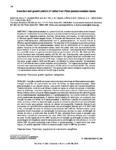Por favor, use este identificador para citar o enlazar este ítem:
http://www.alice.cnptia.embrapa.br/alice/handle/doc/1045154Registro completo de metadatos
| Campo DC | Valor | Lengua/Idioma |
|---|---|---|
| dc.contributor.author | SANTOS, M. R. A. dos | pt_BR |
| dc.contributor.author | GUIMARÃES, M. C. M. | pt_BR |
| dc.contributor.author | PAZ, E. S. | pt_BR |
| dc.contributor.author | MAGALHÃES, G. M. O. | pt_BR |
| dc.contributor.author | SOUZA, C. A. | pt_BR |
| dc.contributor.author | SMOZINSKI, C. V. | pt_BR |
| dc.contributor.author | NOGUEIRA, W. O. | pt_BR |
| dc.date.accessioned | 2016-05-17T11:11:11Z | pt_BR |
| dc.date.available | 2016-05-17T11:11:11Z | pt_BR |
| dc.date.created | 2016-05-17 | pt_BR |
| dc.date.issued | 2016 | pt_BR |
| dc.identifier.citation | Revista Brasileira de Plantas Medicinais, Botucatu, v. 18, n. 1, p.142-148, 2016. | pt_BR |
| dc.identifier.uri | http://www.alice.cnptia.embrapa.br/alice/handle/doc/1045154 | pt_BR |
| dc.description | Piper permucronatum is a perennial shrub, a medicinal plant native to the Amazon Rainforest. Traditionally, the tea of its leaves is used to combat menstrual and intestinal cramps, stomach pain, digestive problems, diarrhea, hemorrhage, and nausea. Its leaf?s essential oil is effective against Aedes aegypti larvae; its flavones and flavanones have a fungicidal effect against Clamidosporium cladosporioides and C. sphaerospermum; its hexanic extract is effective against Leishmania amazonensis. The objective of this study was to provide a protocol for callus induction from P. permucronatum leaves and an identification of the callus growth pattern, focusing on the deceleration phase, when the callus cells must be subcultured into liquid medium in order to produce a cell suspension cultures. Leaf explants were inoculated in a solid MS medium supplemented with factorial combinations of 2,4-D, BA, NAA and GA3. Callus formation was evaluated weekly until the 49th day. Subsequently, new explants were inoculated at the hormonal combination that resulted in the highest callus cell proliferation and, every seven days during a period of 70 days, samples were dried and weighed to determine the callus growth pattern. NAA and GA3 were not effective for callus induction. Combinations of 2,4-D and BA resulted in callus induction and proliferation. The highest percentage of callus induction was observed with the combination of 4.52 µM 2,4-D and 4.44 µM BA. The calluses thereby produced were friable and whitish. The callus growth pattern followed a sigmoid shape. The deceleration phase started on the 56th day of culture. | pt_BR |
| dc.language.iso | eng | eng |
| dc.rights | openAccess | eng |
| dc.subject | Callogenesis | pt_BR |
| dc.subject | Reguladores de crescimento | pt_BR |
| dc.title | Induction and growth pattern of callus from Piper permucronatum leaves. | pt_BR |
| dc.type | Artigo de periódico | pt_BR |
| dc.date.updated | 2016-05-17T11:11:11Z | pt_BR |
| dc.subject.thesagro | Calogênese | pt_BR |
| dc.subject.thesagro | Piperaceae | pt_BR |
| dc.subject.nalthesaurus | growth regulators | pt_BR |
| riaa.ainfo.id | 1045154 | pt_BR |
| riaa.ainfo.lastupdate | 2016-05-17 | pt_BR |
| dc.contributor.institution | MAURICIO REGINALDO ALVES DOS SANTOS, CPAF-Rondonia; UNIR; UNIR; UNIR; Bolsista, Embrapa Rondônia; Bolsista, Embrapa Rondônia; UNIR. | pt_BR |
| Aparece en las colecciones: | Artigo em periódico indexado (CPAF-RO)  | |
Ficheros en este ítem:
| Fichero | Descripción | Tamaño | Formato | |
|---|---|---|---|---|
| 2016RBPMPiperpermucronatum.pdf | 270.15 kB | Adobe PDF |  Visualizar/Abrir |









